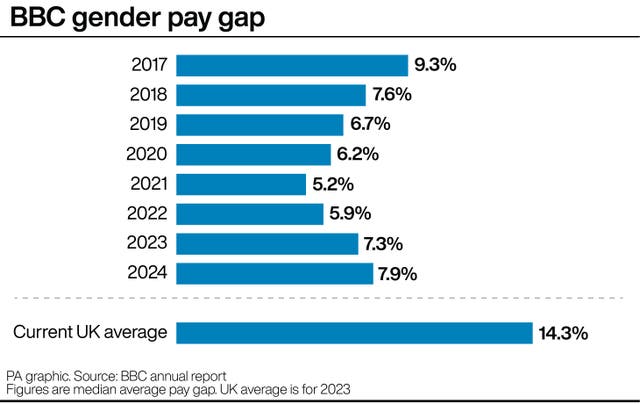BBC gender pay gap widens for third year in a row, latest figures show
The gap had fallen as low as 5.2% in 2021, but has widened in each successive year.

The BBC’s gender pay gap has increased for the third year in a row to its highest level since 2017.
The difference between the median average hourly earnings of men and women across the corporation’s staff as of March 31 2024 was 7.9%, up from 7.3% a year earlier, according to the latest annual report.
It had fallen as low as 5.2% in 2021, but has widened in each successive year.
The BBC said the rise reflects recent investment in technical and IT-related roles, adding that these jobs are “more weighted to men than women”.

Not all career bands at the corporation saw a gender pay gap in the latest year, with the most junior career band recording a negative gap of -2.3%, meaning that average pay for women in this group was higher than for men.
But the BBC’s overall pay gap of 7.9% is the highest since 2017, when it stood at 9.3%.
This is still some way below the national average median gap, which stood at 14.3% in 2023, according to the latest available figures from the Office for National Statistics.
The rise in the gap “continues to be predominately due to specific investments in pay over the past two years, including for critical talent in key roles in our technology and product areas, and for longer serving employees paid towards the bottom of their pay ranges”, the BBC said.
Across the BBC as a whole, 50.4% of the workforce in March 2024 were female, up from 50.1% a year earlier and only the second time 50% has been surpassed in the corporation’s history, meeting a target for 50:50 representation by 2026.
The highest paid woman in 2023/24 was Zoe Ball, presenter of the Radio 2 breakfast show, whose salary was between £950,000 and £954,999: down slightly from the previous year but enough to rank her second overall on the list, behind Match of the Day host Gary Lineker (£1,350,000-£1,354,999).
The other three women in the top 10 on-air salaries are: Question Time presenter Fiona Bruce (£405,000-£409,999); DJ Lauren Laverne (£395,000-£399,999) and news presenter Naga Munchetty (£345,000-£349,999).

The number of women in the top 10 is unchanged from last year and has improved gradually since 2017-18, when the list was entirely made up of men.
Of the 67 names included on the full list, which covers on-air salaries that are above £178,000, 37% are women.
This a lower proportion than last year, when 41% of the 68 names were female.
Meanwhile, just under one in five people on the 2023-24 list (19%) is non-white, down from 22% in 2022-23.
The highest-paid, non-white broadcasters on the 2023-24 list are: Naga Munchetty, who is the first non-white woman to appear in the top 10; Today presenters Mishal Husain (£340,000-£344,999) and Amol Rajan (£310,000-£314,999); and newsreader and presenter Clive Myrie (£310,000-£314,999).
In total there are 13 non-white people on the full list, including economics editor Faisal Islam (£260,000-£264,999); sports presenter Alex Scott (£220,000-£224,999) and news presenter Maryam Moshiri (£185,000-£189,999)
The BBC has pledged that 20% of its total staff will be from ethnic minority backgrounds by 2026.
The figure for 2023-24 was 17.2%, up very slightly from 17.0% the previous year.





